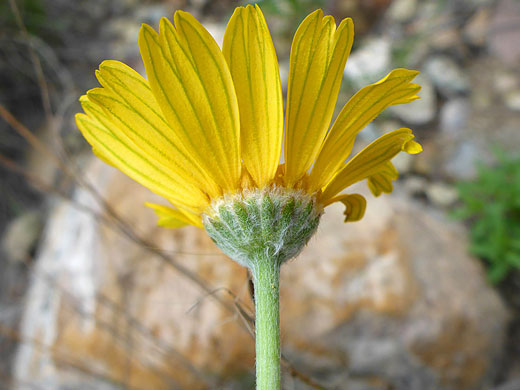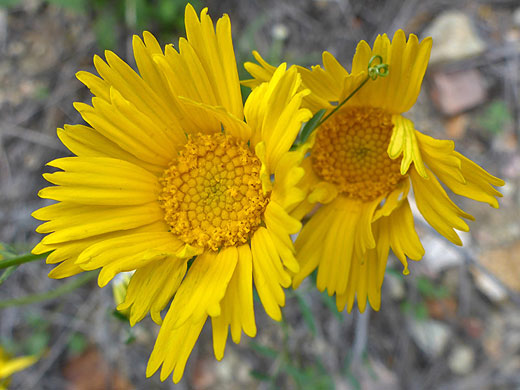Tetraneuris Scaposa, Stemmed Four-Nerve Daisy
Plants > Wildflowers > Asteraceae > Tetraneuris Scaposa

Flowerhead of tetraneuris scaposa with 18 ray florets, Apache Canyon Trail, Big Bend National Park, Texas
Common name:
Stemmed four-nerve daisy
Family:
Scientific name:
Tetraneuris scaposa
Main flower color:
Range:
Colorado, New Mexico, Texas and the southern Great Plains
Height:
Up to 16 inches
Habitat:
Woodland margins, fields, roadsides, slopes
Leaves:
Linear to narrowly oblanceolate, hairy, up to 4 inches long
Season:
March to June
A typical specimen of tetraneuris scaposa, a perennial species, produces several dozen stems to heights of around one foot, bearing leaves at the base (mainly) and the lower part of the stem. Leaves are long and narrow, covered by white hairs, and the surface is specked with small glands. Leaf edges are usually entire, though there may be 2 small lobes near the base.
Stems may be topped by a single flowerhead, or a compact cluster. Flowerheads have 12 to 26 yellow ray florets, partly divided at the tip into three lobes, and 25 to 180 yellow-orange disc florets. Underneath are 8 to 16 green phyllaries, also hairy, especially towards the tips, which are often tinted red. The usual flowering time is spring and early summer, but blooms can appear at any time of the year.
Var scaposa, the most widespread variety, has stems which are not densely hairy, and leaves which are closely spaced, while the less common (Texas only) var argyrocaulon has woolly hairy stems, and less crowded leaves.
Stems may be topped by a single flowerhead, or a compact cluster. Flowerheads have 12 to 26 yellow ray florets, partly divided at the tip into three lobes, and 25 to 180 yellow-orange disc florets. Underneath are 8 to 16 green phyllaries, also hairy, especially towards the tips, which are often tinted red. The usual flowering time is spring and early summer, but blooms can appear at any time of the year.
Var scaposa, the most widespread variety, has stems which are not densely hairy, and leaves which are closely spaced, while the less common (Texas only) var argyrocaulon has woolly hairy stems, and less crowded leaves.
All Contents © Copyright The American Southwest | Comments and Questions | Contribute | Site Map






